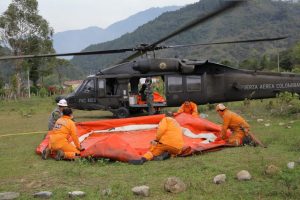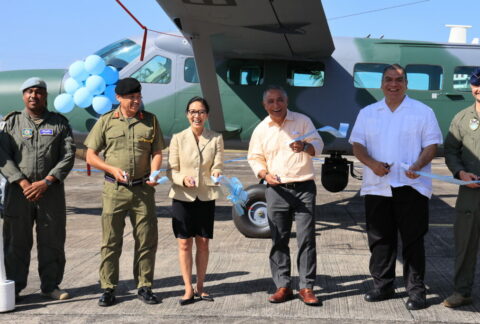Colombian pilots carry out fire extinguishing duties in one of the harshest drought seasons of the last 20 years.
During 2019, the Colombian Air Force (FAC, in Spanish) worked tirelessly to extinguish and control fires. Pilots overflew the territory to extinguish fires that consumed 318,214 acres of vegetation due to strong winds, scarce rain, and high temperatures, in addition to fires created intentionally for agricultural purposes. This combination caused 2,217 fires; the highest number Colombia’s Unit for Disaster Risk Management (UNGRD, in Spanish) has recorded in two decades.
FAC has a helicopter fleet with Bambi Bucket fire-control systems, with a 1,320-gallon capacity. For fires in large areas, FAC deploys a C-130 Hercules aircraft, equipped with a MAFFS II system that can drop a load of 3,698 gallons.
“The complexity of these maneuvers requires planning and attention to aircraft performance. Special consideration must be paid to the high temperatures we face during drops,” said FAC Captain Fabián Grijalba, commander of the 412 Squadron and pilot of a Huey II helicopter. “Because this involves more physical exhaustion among crew members, we only conduct a maximum of six flight hours.”

The most recent fires, which occurred in September, have affected forests in Tolima, Antioquia, Santander, and Valle del Cauca departments. In the latter, in the Yumbo municipality, the fire ravaged more than 791 acres. “In this area, there are cross winds, the terrain is very steep, and vegetation is abundant,” Miguel Perdomo, UNGRD coordinator in Yumbo, told Diálogo. “These characteristics and the distance from water prevent forest control groups from being more flexible.”
In hard-to-reach areas, fire trucks cannot enter, only manual tools can be used. That’s where the FAC firefighters descend on ropes behind the combustion line to create firebreaks and release liquids over the fires. “Following the drops, the flames are extinguished, leaving a safe perimeter for us to come closer,” Carlos Guzmán, a firefighter at the National Firefighting Directorate (DNB, in Spanish) in the municipality of Carmen de Apicalá, Tolima, told Diálogo. “After that, we remove any combustible material to make a path and prevent the fire from advancing through crops or wooded areas.”
“Ninety-eight percent of the fires recorded in October were caused by people who try to prepare the soil for crops,” Captain Germán Miranda, head of DNB, told Diálogo. “There’s also the increase in temperature. In some cities and towns in the Caribbean or Andean regions [the temperatures] can reach up to 43 degrees Celsius [nearly 110 degress Farenheit].”
To increase FAC’s operational capabilities, the U.S. government established in August the Regional Helicopter Training Center Program in Colombia, with the delivery of 60 TH-67 Creek training helicopters. These aircraft will be used to train Colombian pilots at the Helicopter School for the Armed Forces.
“I’d like to thank our friends from the United States and its Army for their support to the Colombian people and Air Force,” said General Ramsés Rueda Rueda, FAC commander, during the delivery of the TH-67 Creek helicopters.









